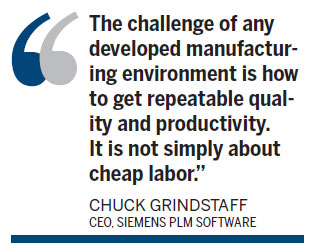Managing product lifecycle is way forward
Updated: 2014-01-02 08:09
By Gao Yuan (China Daily)
|
|||||||||||

Yet PLM systems are severely underdeveloped in the world's second-largest economy famous for its role as the world's factory.
China accounted for 3.5 percent of the overall share of the global comprehensive PLM market last year.
The nation's export-oriented economy has been hit by the global economic downturn since 2008.
"China needs to build an innovation-driven manufacturing industry to put more added-value into its exports," said Holmes.
Traditional manufacturers in China will require new technology to keep their global competitiveness, he said.
According to a HSBC Holdings Plc report, China's manufacturing Purchasing Managers' Index, a gauge of domestic manufacturing activity, may decrease in December from an eighth-month high in November.
Data from the National Bureau of Statistics indicated the manufacturing PMI was 51.0 in December, the lowest one in 2013.
"Because China's economy remains export-oriented, the employment rate and earnings in the private sector are closely related to the global economic atmosphere," said Holmes, adding that because the European Union and other major trade partners of China are still in recession, Chinese firms need better cost-control and higher quality.
More vertical sectors, such as healthcare and digital manufacturing, will need a PLM system to boost work efficiency.
"The global economy is kind of funny right now. The weather is changing on a daily basis. This does put some pressure on the timing of the projects but our business has been quite strong around the world," said Grindstaff.
"For us, it's the value that we can provide after the implementation and we are trying to lower the cost barrier to get more implementation," he said.
"As China is moving to further develop its aerospace and commercial jetliners, I would like to show our tools to the large number of potential customers in China."
Reshoring
Grindstaff first joined the company in 1978 when it was known as Unigraphics Solutions. He held a number of research and development positions during his first decade with the organization.
He subsequently left the company to serve as president and chief executive officer of Waveframe Corp, a developer of digital signal processing systems for high-end motion picture applications.
Grindstaff returned to Unigraphics in 1994. After the company was acquired by Siemens AG, he became company CEO in October 2011.
The 56-year-old, who enjoys skiing, sailing, cycling and hiking, currently lives in Dallas, Texas.
He said that because of the increasing cost of logistics and shipping, manufacturing is shifting back to the US and other developed economies, a process that started last year.
Related Stories
Siemens ends 2013 with strong growth in China 2013-11-14 13:47
Siemens provides the 'brain' for Wuhan's traffic control system 2013-10-23 07:19
Siemens to cut 15,000 jobs by autumn 2014 2013-09-30 09:14
Siemens (China) SEWC in Chengdu 2013-09-26 16:44
Siemens and Tangshan Iron and Steel sign major agreement 2013-07-15 09:57
Today's Top News
Palestine sends delegation to probe envoy's death
IOC President condemns terrorism
Antarctic helicopter rescue delayed
Putin meets Volgograd bombing victims
Diplomacy to focus on neighborhood
Former Israeli PM's health worsens
NGO ends SOS on funding
Palestinian envoy in Prague killed
Hot Topics
Lunar probe , China growth forecasts, Emission rules get tougher, China seen through 'colored lens', International board,
Editor's Picks

|

|

|

|

|

|





